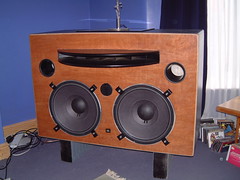Maybe it was a result of the divide between home HiFi and studio equipment that started to take shape at that time, and JBL certainly used the studio connection in their marketing. AR then, I remember, where quick to point out that their speakers where HiFI speakers and not studio ones (this was a lie as Motown used AR 3 speakers for monitoring).
JohanR
Hitsville USA, located at 2648 West Grand Boulevard in Detroit, Michigan, and purchased by Berry Gordy in 1959, was Motown's original headquarters, housing its administrative offices and, at the back of the building, its recording studio, the live area of which was commonly referred to as 'The Snake Pit'. In 1965, this was supplemented by a mix room located at 2644 West Grand, yet Studio A was where the classic hits were recorded, and it stayed open 24 hours a day, 365 days a year, until the company relocated to Los Angeles in 1972. (The offices moved to a 10-storey building in downtown Detroit in 1968.)
Mike McLean, who joined Motown in January 1961, was the Chief Engineer, and he initially built a pair of half-inch, three-track machines with Sel-sync using Ampex parts. The Marvelettes' 'Please Mr Postman' was recorded during the first three-track session. In addition to the
Altec 605A monitors positioned in each corner near the ceiling, the control room housed a five-input, rack-mounted Altec 1567A tube mixer and four-input Ampex MX10. The limited number of effects included an EMT 140 plate reverb and an echo chamber in the attic that had been built by Pop Gordy, Berry's father, with parallel plasterboard walls, a door at each end and an RCA 44BX mic to capture the flutter echo. Other mics included a Neumann U47 and U48, two Electro Voice 666s, a pair of RCA 44BXs and an RCA 77DX. Later on, as part of the 'factory' approach, there would be a switch to all Neumann KM86 condenser mics.
During the early years, it was normal to have the lead vocal on track one, run through a Fairchild 660 mono compressor/limiter and the Altec 1567A. Horns and backing vocals would be on track two, going through a small custom-built console, and the rhythm section, routed to the Ampex MX10, was on track three. Tracks two and three would be cut together, but there wasn't much room for strings, so in 1964 McClean built an Ampex-based one-inch, eight-track machine that was used for the Supremes' 'Where Did Our Love Go'. This would remain until the purchase of a two inch, 16-track four years later, at which time Motown also upgraded to a conventional, state-of-the-art console and
Altec 604E monitors.
The mix room at 2644 West Grand had its own eight-input custom console, featuring Langevin slide pots, Centralab rotary pots and API VU meters, along with
604E monitors, Studer C37 two-track tape machines and three echo chambers. Nevertheless, the consensus of opinion among those who played on the classic '60s recordings is that these chambers were outstripped by the one at 2648 West Grand as a contributing factor to the 'Motown Sound'.
"We were always trying different things," says Lamont Dozier. "The recording process was definitely more innovative back then, without synthesizers, and we'd have to improvise on the spot, banging on the piano, using car tyre snow chains anything to get different effects. By the mid-'60s, everybody was looking for new sounds and new conversation pieces, and so we'd do things to make people wonder, 'What was that?' I mean, we didn't have the luxury that the Beatles enjoyed of always having new equipment invented for us, so we'd just beat on boxes, stomp on two-by-four hardwood floorboards for 'Where Did Our Love Go' whatever we could come up with... and get away with."




